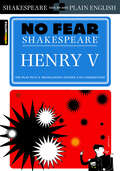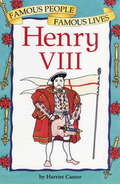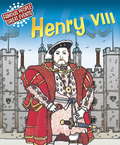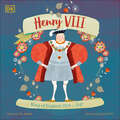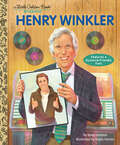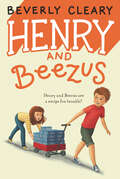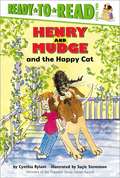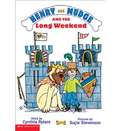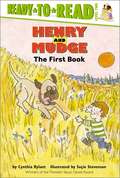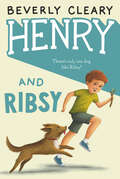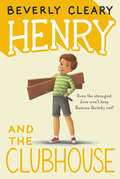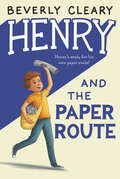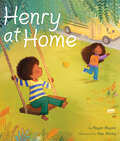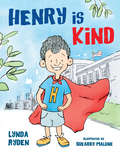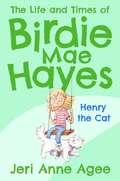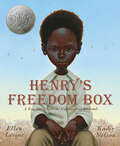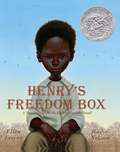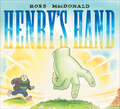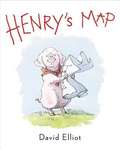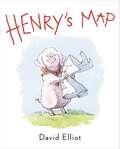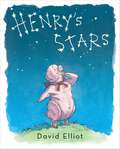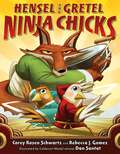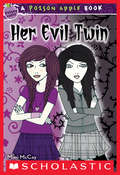- Table View
- List View
Henry V: No Fear Shakespeare Side-by-Side Plain English (No Fear Shakespeare)
by William Shakespeare SparkNotesThis No Fear Shakespeare ebook gives you the complete text of Henry Vand an easy-to-understand translation.Each No Fear Shakespeare containsThe complete text of the original playA line-by-line translation that puts Shakespeare into everyday languageA complete list of characters with descriptionsPlenty of helpful commentary
Henry VIII: Famous People, Famous Lives
by Harriet CastorExciting stories about famous people, outlining their lives and the important events which made them memorable. Every page features easy-to-follow text and a black-and-white line drawing to help bring these events to life. Each title gives further facts about the famous person and the times in which he or she lived, plus a comprehensive time line detailing key dates. Henry VIII is an exciting tale of kings and queens, jousting knights and grisly executions. It explains how Henry took power away from the Church in his quest for an heir to inherit his kingdom.
Henry VIII: Famous People, Great Events
by Harriet CastorExciting stories about famous people, outlining their lives and the important events which made them memorable. Every page features easy-to-follow text and a black-and-white line drawing to help bring these events to life. Each title gives further facts about the famous person and the times in which he or she lived, plus a comprehensive time line detailing key dates. Henry VIII is an exciting tale of kings and queens, jousting knights and grisly executions. It explains how Henry took power away from the Church in his quest for an heir to inherit his kingdom.
Henry VIII: King of England 1509 - 1547 (History's Great Leaders )
by Ben HubbardDelve into the past and explore the life and reign of Henry VIII in this biography for children brought to you by the publisher of Queen Elizabeth: A Platinum Jubilee Celebration and King Charles III.The third book in this captivating series on British monarchs, Henry VIII covers all the key moments in the fascinating man's life, from his struggles to father a son and the fates of his six wives, to the formation of the Church of England and wars with France and Scotland.Bright, playful illustrations and simple, age-appropriate text ensure that this book is the perfect introduction to the infamous Tudor king for little historians everywhere. It will supplement your child's learning and curiosity as it reveals the secrets of a larger-than-life king from long ago.
Henry Winkler: A Little Golden Book Biography (Little Golden Book Biographies)
by Betsy GrobanCelebrate beloved actor and children's book author Henry Winkler with this collectible Little Golden Book, featuring an accessible font for readers with dyslexia!Henry wants all children with dyslexia to know that they are smart and can do great things.Henry Winkler has never let anything stop him from following his dreams, from growing up in New York City with a learning disability to his iconic role as The Fonz on TV's Happy Days, to his success as a children's book author and advocate for helping children with learning challenges. This heartwarming biography includes full-color illustrations and a special font used to make reading more accessible for people like Henry who struggle with dyslexia.This Little Golden Book Biography is perfect for Henry Winkler fans of all ages and families looking for inspiring stories about people with learning disabilities.Little Golden Book biographies feature the iconic gold-foil design and share the life stories of extraordinary artists, world leaders, performers, and athletes including:Oprah WinfreyCarol BurnettDick Van DykeSteven Spielberg
Henry and Beezus (Henry Huggins #2)
by Beverly Cleary Tracy DockrayFor the well-meaning Henry Huggins, nothing ever works out quite as planned—including getting the bike of his dreams. Luckily his pal Beezus Quimby is there to help!<P><P> Henry's attempts at raising money for his bike fund keep falling flat. Selling bubble gum on the playground gets him in trouble with his teacher, and then Ribsy's nose for mischief almost ruins Henry's paper route. Even pesky little Ramona Quimby manages to get in the way of Henry's chance at a bike. But no matter what, Henry can always count on reliable Beezus to stick by his side.<P> Newbery Medal winner Beverly Cleary portrays a genuine friendship, while telling a very funny story boys and girls alike will enjoy.
Henry and Mudge and the Happy Cat (Henry and Mudge #8)
by Cynthia RylantIn this eighth book in the Henry and Mudge series, Henry and his dog Mudge take in a stray cat. It's not a pretty cat, but it is a happy cat and it loves Mudge!
Henry and Mudge and the Long Weekend: The Eleventh Book of Their Adventures
by Cynthia Rylant Suçie StevensonNIMAC-sourced textbook
Henry and Mudge: The First Book of Their Adventures
by Cynthia Rylant<P>When Henry asks his parents for a baby brother, they say "No!" When Henry begs to move to a street with children, his parents say "No!" When Henry asks for a dog, his parents almost say "No!" Good thing they didn't say it, because Henry and Mudge are best pals. <P>Other books about their adventures are available from Bookshare. [This text is listed as an example that meets Common Core Standards in English language arts for grades 2-3 at http://www.corestandards.org.]
Henry and Ribsy (Henry Huggins #3)
by Beverly Cleary Tracy DockrayHenry's father promises to take him salmon fishing if he can keep Ribsy out of trouble for the next month. But that's no easy task, especially when Ramona gets into the act.In this humorous and heartfelt novel from Newbery Medal-winning author Beverly Cleary, the bond between a boy and his dog proves strong, as Henry vows to stick up for Ribsy... even if he is a trouble-maker!<P><P> From the first moment Henry found Ribsy, the curious mutt was poking his nose into things he shouldn't be. Whether terrorizing the garbage man, chasing cats, or gobbling Ramona Quimby's ice-cream cone, Henry's four-legged pal has walked himself into one problem too many. So when Henry asks his dad if he can go along on the big fishing trip, Mr. Huggins agrees, but on one condition: Ribsy must stay out of mischief for two whole months. Henry is confident in his loyal dog... until Ribsy goes overboard with his appetite for chaos... literally!<P> Winner of Pacific Northwest Library Association’s Young Reader’s Choice Award
Henry and the Clubhouse (Henry Huggins #5)
by Beverly Cleary Tracy DockrayFiery Ramona Quimby and the well-meaning Henry Huggins may clash, but in this delightful and hilariously told novel by Newbery Medal-winning author Beverly Cleary, an unlikely compromise wins the day.<P><P> Henry and his friends are building a no-girls-allowed clubhouse. With a private space of their own away from everyone else—and even a top secret entry password—they're all thrilled with their boy fort. But Henry's about to find out that nothing—not even a sign—will keep gutsy Ramona out of their clubhouse…and her retaliation may just ruin Henry's newspaper career.
Henry and the Paper Route (Henry Huggins #4)
by Beverly Cleary Tracy DockrayNewbery Medal-winning author Beverly Cleary gives readers a hero they'll relate to--and root for--in this comical and inspiring novel about Henry Huggins's mission to prove himself worthy of his very own paper route.<P><P> All the older kids work their own paper route, but because Henry is not eleven yet, Mr. Capper won't let him. Desperate to change his mind, Henry tries everything he can think of to show he's mature and responsible enough for the job. From offering free kittens to new subscribers, to hauling hundreds of pounds of old newspapers for his school's paper drive, there's nothing Henry won't try. But it might just be the irrepressible Ramona Quimby who shows Mr. Capper just how capable Henry is.<P> Winner of Pacific Northwest Library Association’s Young Reader’s Choice Award
Henry at Home
by Megan MaynorThe love between a brother and sister shines through in this reassuring picture book about a common childhood transition—an older sibling starting school and leaving the younger one behind.Liza is Henry's big sister, and Henry is Liza's little brother. As long as there has been a Henry and Liza, they have always done everything together. Haircuts, birthday parties, tree climbing, even flu shots. Liza and Henry. Henry and Liza. But that all changes when Liza starts school for the first time, heading off to kindergarten and leaving her little brother behind. Henry is incredulous. How can Liza do this to him?This true-to-life picture book, gorgeously illustrated, explores a sweet sibling relationship and carries an important and reassuring message about family and growing up.
Henry is Kind: A Story Of Mindfulness
by Shearry Malone Linda RydenA classroom-tested resource for social and emotional learning Henry’s discovery of the many ways he can be kind will inspire young readers to use the simple mindfulness practices taught in this book to develop their own capacities for kindness. Ms. Snowden and her class practice sending kind thoughts to the people they love, and they launch a class Kindness Project. There is only one problem: Henry can’t think of one kind thing he has done. Declaring that kindness is stupid, he stomps to the classroom door on the verge of tears, but his classmates save the day by reminding him of the kind things he has done for each of them.
Henry the Cat: The Life and Times of Birdie Mae Hayes #2 (Life and Times of Birdie Mae Hayes #2)
by Bryan Langdo Jeri Anne AgeeBirdie has a new pet—that no one else can see!Birdie Mae Hayes is getting a handle on her new gift: her ability to sense and see things before they happen. Then, one morning, a fluffy white cat appears at her window, making himself at home. Cute! She names him Henry. Only . . . no one else can see this cat. Just Birdie. Here we go again!Even Grandma Mae doesn't know why Henry the cat is there. But he keeps showing up, and he seems to know things that even Birdie's gift doesn’t show her. Is he there to help Birdie—or is there something he needs from her? Birdie is ready to find out on an adventure all over town!
Henry's Freedom Box
by Ellen LevineA stirring, dramatic story of a slave who mails himself to freedom by a Jane Addams Peace Award-winning author and a Coretta Scott King Award-winning artist.Henry Brown doesn't know how old he is. Nobody keeps records of slaves' birthdays. All the time he dreams about freedom, but that dream seems farther away than ever when he is torn from his family and put to work in a warehouse. Henry grows up and marries, but he is again devastated when his family is sold at the slave market. Then one day, as he lifts a crate at the warehouse, he knows exactly what he must do: He will mail himself to the North. After an arduous journey in the crate, Henry finally has a birthday -- his first day of freedom.
Henry's Freedom Box: A True Story From The Underground Railroad
by Ellen Levine Kadir NelsonA stirring, dramatic story of a slave who mails himself to freedom by a Jane Addams Peace Award-winning author and a Coretta Scott King Award-winning artist. <P> Henry Brown doesn't know how old he is. Nobody keeps records of slaves' birthdays. All the time he dreams about freedom, but that dream seems farther away than ever when he is torn from his family and put to work in a warehouse. Henry grows up and marries, but he is again devastated when his family is sold at the slave market. Then one day, as he lifts a crate at the warehouse, he knows exactly what he must do: He will mail himself to the North. After an arduous journey in the crate, Henry finally has a birthday -- his first day of freedom.<P> Winner of the Caldecott Honor
Henry's Hand
by Ross MacdonaldHenry’s Hand is a story about the friendship between Henry, a giant, and his right hand. You see, Henry sometimes has trouble keeping track of his body parts—everything from his ears to one of his legs can fall off. Once, his eye even rolled under the couch and wouldn’t come out until bedtime. But with help from Hand, Henry keeps himself together. In fact, Henry and Hand are the best of friends . . . that is, until Henry takes Hand for granted, pushes him too far, and Hand runs away. A charming tale of friendship, forgiveness, and loyalty, Henry’s Hand is also a quirky story for readers of all ages, especially those of us who know what it feels like to fight with your best friend.
Henry's Map
by David ElliotA fun-filled introduction to maps through the eyes of an adorable pig Henry is a very particular sort of pig. "A place for everything and everything in its place," he always says. But when he looks out his window he is troubled. The farm is a mess! Henry is worried that nobody will be able to find anything in this mess. So he draws a map showing all the animals exactly where they belong. And Henry embarks on a journey through the farm, his friends tagging along as he creates his map: sheep in the woolshed, chickens in the coop, the horse in the stable. After the map is complete, Henry uses it to bring himself back home, where he is relieved to know that he is exactly where he belongs. A place for everything and everything in its place, indeed. For fans of Zen Shorts by Jon J. Muth or of Winnie the Pooh, this sweet romp through the farm is adorably illustrated by David Elliot, who created the endearing animals who inhabit Brian Jacques world of Redwall. Perfect for pre-schoolers and elemetary-schoolers learning to read maps for the first time.
Henry's Map
by David ElliotA fun-filled introduction to maps through the eyes of an adorable pigHenry is a very particular sort of pig. "A place for everything and everything in its place," he always says. But when he looks out his window he is troubled. The farm is a mess! Henry is worried that nobody will be able to find anything in this mess. So he draws a map showing all the animals exactly where they belong. And Henry embarks on a journey through the farm, his friends tagging along as he creates his map: sheep in the woolshed, chickens in the coop, the horse in the stable. After the map is complete, Henry uses it to bring himself back home, where he is relieved to know that he is exactly where he belongs. A place for everything and everything in its place, indeed.For fans of Zen Shorts by Jon J. Muth or of Winnie the Pooh, this sweet romp through the farm is adorably illustrated by David Elliot, who created the endearing animals who inhabit Brian Jacques world of Redwall. Perfect for pre-schoolers and elemetary-schoolers learning to read maps for the first time.Praise for Henry's Map:*** “With appealing characters and gentle humor, this book will be a hit at storytime, or as an introduction to mapping lessons.” —School Library Journal *** (starred) *** “Here’s hoping for many more Henry-centric adventures.” —Kirkus Reviews *** (starred) “Elliot’s barnyard animals brim with personality and emotion, matching the understated humor of this charming story.” —Publisher’s Weekly “This story may even inspire budding cartographers to map their own world.” —Booklist
Henry's Stars
by David ElliotThe stars take shape in this adorable companion to Henry's Map! One beautiful evening on the farm, Henry stares up at the sky. As he looks from star to star, they seem to form a picture. He sees it! A great big starry pig! Henry can&’t wait to show his friends. Yet instead of seeing the Great Pig&’s ears, legs, and curly tail, the sheep see a woolly body . . . the Great Sheep! Abigail sees the Great Star Cow, of course, and the chickens spot Heavenly Hens flying all over the place. Henry is frustrated. Why don&’t the others see what he sees? In this charming companion to Henry&’s Map, David Elliot explores—with gentle humor—the nature of art and perception. A perfect book for kids and adults who love to find shapes among the stars or anywhere else their imaginations may lead.Praise for Henry's Stars"Elliot&’s watercolor and pencil illustrations seamlessly blend the realism and farce that makes this story work so well. Teachers will enjoy using this story to exemplify point of view or introduce a unit on constellations. Younger audiences will relate to Henry and delight in the predictability of his predicament. This modern-day fable deserves a place in most collections."—School Library JournalPraise for Henry&’s Map One of School Library Journal's Best Books in 2013! * &“With appealing characters and gentle humor, this book will be a hit at storytime, or as an introduction to mapping lessons.&” —School Library Journal, starred review * &“Here&’s hoping for many more Henry-centric adventures.&” —Kirkus Reviews, starred review &“Elliot&’s barnyard animals brim with personality and emotion, matching the understated humor of this charming story.&” —Publishers Weekly &“This story may even inspire budding cartographers to map their own world.&” —Booklist
Hensel and Gretel: Ninja Chicks
by Corey Rosen Schwartz Rebecca J. GomezA clever twist on Hansel and Gretel that proves ninja chicks are anything but chicken! When Hensel and Gretel&’s dad gets snatched by a fox, the sisters put their ninja skills to work to track him down before he can be stir-fried. But are these two little chicks ready to take on a dark tangled forest, a tricky house made of corn bread, and an even trickier fox? This plucky pair isn&’t giving up without a fight! Kiya!Kids will fight over this new offering from the team behind The Three Ninja Pigs and Ninja Red Riding Hood.
Her Evil Twin: Her Evil Twin (Poison Apple #6)
by Mimi McCoyIs Anna's new BFF really her evil twin? Nothing is as it seems in this thrilling, bone-chilling new Poison Apple book!Anna's new friend, Emma, is everything Anna wants to be -- fearless, effortlessly fashionable, and always up for doing something new and fun. The girls even look alike, and soon they're fixing their hair the same way and sharing clothes.But Emma is also kind of a troublemaker. She likes to sneak off school grounds at lunch, and she doesn't seem to like Anna having any other friends. Emma never seems to get caught, but Anna does. After all, they look just alike.When Emma's sense of adventure takes a sinister turn, Anna starts to worrry. Is her mirror-image BFF a dangerous evil twin?
